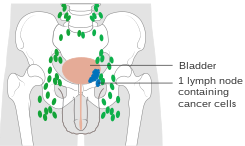
If an abdominal CT scan shows a normal bladder, don’t celebrate yet.
But if it comes back indicating cancer, don’t panic yet, either.
About 80,000 people in the U.S. are diagnosed with bladder cancer every year. The five year survival rate, on average, is about 76.8 percent.
This not-so-good survival rate is a function of the disease being caught at a later stage than it is of just a hard-to-treat cancer.
About four times more men get bladder cancer than do women.
Prevalence in Age Groups
• Under 20: 0.1%
• 20-34: 0.4%
• 35-44: 1.3%
• 45-54: 6.1%
• 55-64: 18.3%
• 65-74: 29.8%
• 75-84: 28.8%
• 85+ 15.1%
Abdominal CT Scan and the Detection of Bladder Cancer
“CT scan is able to detect large bladder irregularities, but not always small lesions,” says Dana Rice, MD, a board certified urologist and creator of the UTI Tracker mobile app, which helps patients catalog daily urinary tract symptoms, medication and behavioral patterns, and offers personalized tips for UTI prevention.
“Also, because the bladder is not a solid organ it is very easy to mistake a bladder fold for an abnormal finding and vice versa,” continues Dr. Rice.
“For instance, a CT scan may list or read a ‘filling defect’ which means contrast dye does not fill the bladder evenly.
“In this situation the ‘defect’ may be from many causes, i.e., blood clot, prostate tissues, ureterocele [benign congenital structural abnormality], bladder tumor and more.
“Other times, the CT scan can appear completely normal and there may be small tumors not seen or carcinoma in situ (CIS).
“For these reasons, cystoscopy to examine the bladder is the gold standard diagnostic test.”

What is a cystoscopy?
It’s a diagnostic procedure (performed either under local anesthetic or general anesthesia) during which a doctor inserts a cystoscope (hollow tube) equipped with a lens into the urethra and further into the bladder.
This enables viewing of the urethra (through which urine flows out of your body) and the lining of the bladder.
“Symptoms of bladder cancer have varying presentations,” says Dr. Rice.
“Symptoms of UTI without documented infections should be worked up by a physician to rule out anatomical abnormalities, stones and cancers.”
For more information on the UTI Tracker, go to utitracker.com.
 Dana Rice, MD, is with Inova Medical Group in Fairfax, VA, and her clinical interests include bladder, kidney and prostate cancer, minimally invasive surgery and robotic surgery.
Dana Rice, MD, is with Inova Medical Group in Fairfax, VA, and her clinical interests include bladder, kidney and prostate cancer, minimally invasive surgery and robotic surgery.
 Lorra Garrick has been covering medical, fitness and cybersecurity topics for many years, having written thousands of articles for print magazines and websites, including as a ghostwriter. She’s also a former ACE-certified personal trainer.
Lorra Garrick has been covering medical, fitness and cybersecurity topics for many years, having written thousands of articles for print magazines and websites, including as a ghostwriter. She’s also a former ACE-certified personal trainer.







































